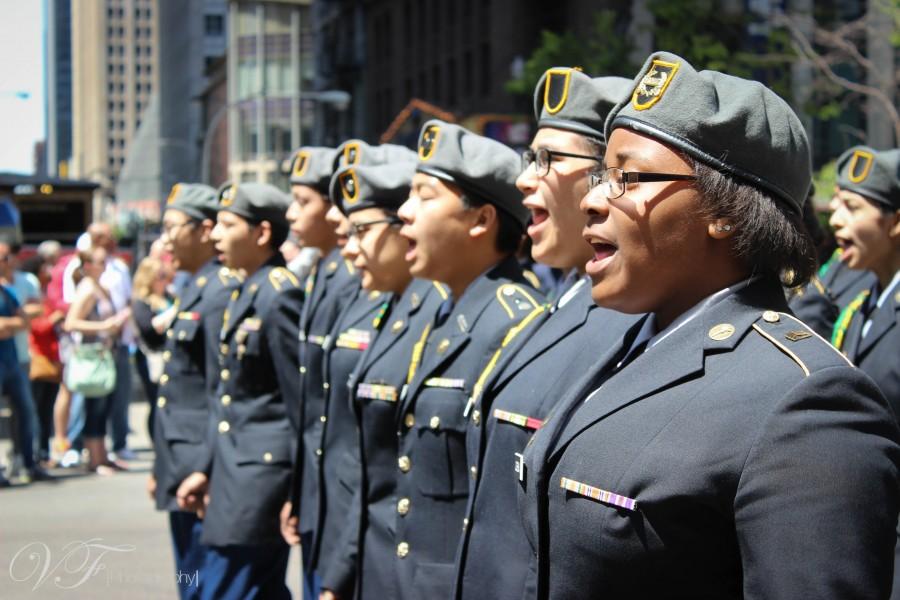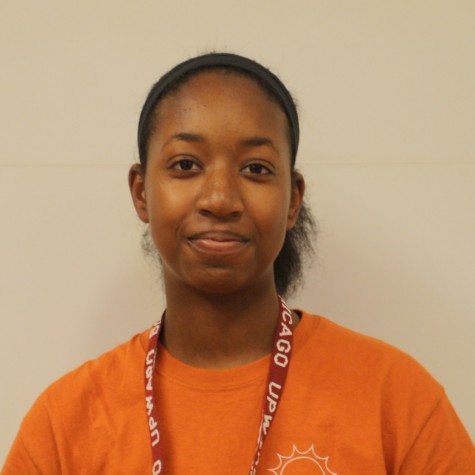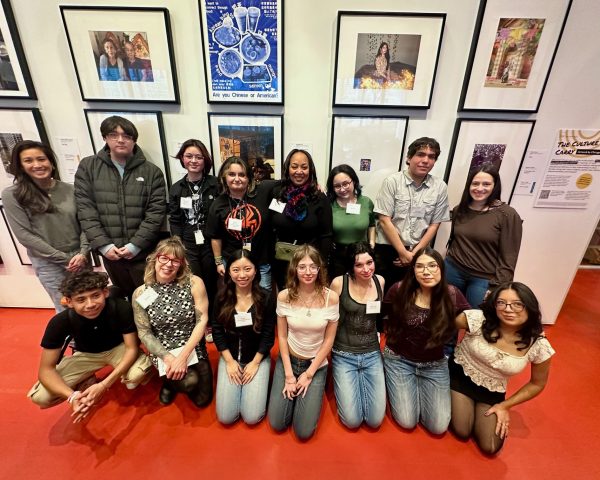JROTC’s City Corps represents Lane throughout Chicago
Cadets partake in Memorial Day parade. Right to left: Sharae Corbin (Div.762), Doreyda Rivera (Div.766), and Darryl Bustalena (Div.654).
“Left, left, left-right-left!”
The cadets move in unison, arms glued to their sides as they look straight ahead. Faces set, mouths in a straight line. They wear blue uniforms with sparkling black shoes. Every audience member can hear the tap tap tap of the cadets’ shoes. They are marching in the Memorial Day Parade downtown.
These students are a part of a program called JROTC (Junior Reserves Officer Training Corps) which is incorporated into many high schools in Chicago, including Lane Tech. JROTC was first established in 1916 under the National Security Act of the United States, and according to Title 10 Section 2031 of the United States code its purpose is to instill in students in the United States secondary educational institutions the values of citizenship, service to the United States, personal responsibility and a sense of accomplishment.
“Originally, I had planned to join the military so doing JROTC was meant to give me a taste of that lifestyle,” said Keauna Pierce, Div. 777.
Sergeant Demar, the sophomore year teacher in JROTC, said, “A lot [of JROTC students] go to the military however we stress that they go on and have an education. Our first goal is that they graduate for high school, and our second goal is for them to get scholarships.”
JROTC has many teams that cadets have a chance to join, including Archery, Drill (Freshman Team & Upperclassmen Team), Junior Leadership/Academic Bowl, Color Guard, Honor Guard, Drumline, Orienteering, Raiders, and Physical Training Team (PT). Cadets can also partake in staffs which help keep the Battalion running smoothly. Participants on the teams have a chance to compete in competitions against other high school students a part of JROTC. Cadets learn different skills, such as coordination and precise movements in drill, playing the drums and marching at the same time in drumline, perfecting aim in archery, and becoming fit in PT.
“The main reason I joined JROTC was because of the chance to be a part of archery,” said Jordan Alcantar, Div. 650.
Cadets and teachers alike see the growth after the students first year of JROTC.
“You see [cadets] growing up. They go from being a shy freshman to an outspoken senior,” said First Sergeant Torres, junior and senior teacher in JROTC.
“You see students freshman year who are shy and afraid to speak in public, and now I have seen them grow into leaders in the JROTC program and able to handle stress, and they’re grades become better,” said Sergeant Demar.
Jordan Alcantar, Div 650, agrees that she has grown as a person during her four years of being a part of JROTC.
“I have acquired confidence and leadership skills, and so I’m glad that I listened to my cousin, who told me about JROTC, and joined.”
Another part of JROTC that contributes to the success and mastery of many cadets is City Corps. City Corps, according to Monica Osnaya, Div. 751, who is the primary J3 (in charge of training and operations in City Corps), is “a staff made up of JROTC students from around the city that basically manage city wide JROTC events and the JROTC program itself.”
Only 21 out of 11,000 cadets are chosen to be a part of City Corps. Cadets who are chosen are involved with their high school JROTC and have completed and passed all three phases of the process to be selected to be a part of City Corps.
The first phase was writing and submitting the application. Cadets had to submit a resume and an explanation as to why they wanted to be in City Corps and in a certain position, along with an essay. The second phase was team building and leadership exercises, which was analyzed and those who passed the second phase moved on to the third phase. The third phase was going to a summer leadership camp called JROTC Cadet Leadership Challenge (JCLC), which promoted new team building and leadership experience.The downside to competing in the phases is that it takes much energy and time.
“I was honestly very nervous while going through these tests because each of them involved having to stand out in some way,” said Osnaya. “It was difficult for me because I’ve always been kind of shy so I wasn’t sure I would be able to do it, but since it was something I really wanted I tried to put that shyness off to the side as much as possible.”
After the last phase only 21 students came back home from the summer with a position on City Corps. Along with Monica Osnaya, two other cadets are on City Corps.
Every year, those 21 cadets plan out different events cadets city wide can partake in, such as Military Ball. Military Ball is also offered in high school JROTC such as Lane.
Male cadets have to wear their uniform, but females are allowed to wear dresses. All cadets sit together during dinner, and go through certain procedures before going off to dance, drink punch, and have snacks.
City Corps is one way to become deeper involved with leadership opportunities through JROTC. There are many other programs that can lead a cadet to discovering their career, enhancing leadership skill, and discovering hidden talents through joining clubs and teams.
To those prospective ninth graders who would like to join JROTC next year:
“If prospective JROTC students stay focused and listen to the curriculum we teach, they are guaranteed to become successful high schoolers,”said Sergeant Demar.
Your donations directly fund the Lane Tech student journalism program—covering essential costs like website hosting and technology not supported by our school or district. Your generosity empowers our student reporters to investigate, write, and publish impactful stories that matter to our school community.
This website is more than a publishing platform—it's an archive, a research tool, and a source of truth. Every dollar helps us preserve and grow this resource so future students can learn from and build on the work being done today.
Thank you for supporting the next generation of journalists at Lane Tech College Prep!





